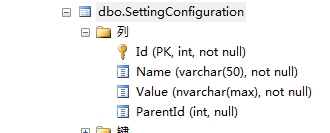今天遇到一個問題,怎麼在where裡判斷一個字段是否為null,並且這個字段不是字符串string類型,而是int和GUID類型,折騰了半天終於搞明白了。(由於項目是我半路接手的,問題是前期的同事給我挖了一個坑,我今天就是填坑的)
1.在說這個問題之前,我先說一下數據庫的表與C#之間model的對應:
一般數據庫中的表我們都可以使用代碼生成器(東軟代碼生成器)生成,其中字段的可空不可空也會給我們生成,如:表

用代碼生成器生成的model是:

數據庫中我們可以看到ParentId這個字段是可以為空的,其他字段不能為空;
對應到代碼生成器生成的代碼Model就可以看到代碼:
public int? ParentId
{
set{ _parentid=value;}
get{return _parentid;}
}
主要是int?
有些能不知道這個int?是什麼意思?和int有什麼區別?這裡簡單說一下兩者之間的區別:int?是可以為null的,而int是不能賦值null的:如下面兩個代碼:
int? a = null; //編譯成功
int a = null; //編譯錯誤。
int?允許把null賦值給數值型,這個是為了兼容SQL或者其它數據庫中Null這個空值所設定的。
所以:在把數據庫的表轉化成model時,一定要把可為空的字段轉化成對應的可為空的C#字段:
主要有
int——>int?
Guid——>Guid?
DateTime——>DateTime?
short——>short?
decimal——>decimal?
注意:有人說string為什麼不轉化成string? 額額額額~~~~~你傻呀,string類型的字段本來就可以為null,何必要寫出string?,多此一舉。
通過上面的介紹,大家一定對數據庫表轉化成model有了一定的了解。那麼我們就言歸正傳,說問題:
2.問題的根源
問題的根源就是同是在建model的時候,該轉化的沒轉化,導致我查詢一而再、再而三的失敗。
對於可以為null的字段,如果要判斷這個字段是不是null,比如我們在查詢表SettingConfiguration中ParentId是null的數據,我們就可以這樣寫:
var dtvar = (from des in db.SettingConfiguration
where(des.ParentId==null)
select des);
這樣查詢肯定沒問題的,可以~~~~嘿嘿嘿嘿嘿嘿~~~
如果你在建model的時候ParentId的字段是
public int ParentId
{
set{ _parentid=value;}
get{return _parentid;}
}
這樣寫的,那你怎也查不到數據,並且還不會報錯,讓你郁悶終生(我就是這麼郁悶的),郁悶郁悶,在網上找了很多方法,都不能查詢出數據,
後來改了一下model之後,什麼問題都解決了,這就是一個大坑,讓我填平了,同時在提醒大家,建model一定要和數據庫對應,要不然以後坑的都是自己。
下面提供一些很有用的查詢null的方法:
SELECT * FROM [Orders] AS [t0] WHERE ([t0].[ShippedDate]) IS NULL
方法一:
from o in Orders where o.ShippedDate==null select o
對應的Lamda表達式為:
Orders .Where (o => (o.ShippedDate == (DateTime?)null))
對應的SQL語句為:
SELECT [t0].[OrderID], [t0].[CustomerID], [t0].[EmployeeID], [t0].[OrderDate], [t0].[RequiredDate], [t0].[ShippedDate], [t0].[ShipVia], [t0].[Freight], [t0].[ShipName], [t0].[ShipAddress], [t0].[ShipCity], [t0].[ShipRegion], [t0].[ShipPostalCode], [t0].[ShipCountry] FROM [Orders] AS [t0] WHERE [t0].[ShippedDate] IS NULL方法二:
from o in Orders where Nullable<DateTime>.Equals(o.ShippedDate,null) select o
對應的Lamda表達式為:
Orders .Where (o => Object.Equals (o.ShippedDate, null))
對應的SQL語句為:
SELECT [t0].[OrderID], [t0].[CustomerID], [t0].[EmployeeID], [t0].[OrderDate], [t0].[RequiredDate], [t0].[ShippedDate], [t0].[ShipVia], [t0].[Freight], [t0].[ShipName], [t0].[ShipAddress], [t0].[ShipCity], [t0].[ShipRegion], [t0].[ShipPostalCode], [t0].[ShipCountry] FROM [Orders] AS [t0] WHERE [t0].[ShippedDate] IS NULL方法三:
from o in Orders where !o.ShippedDate.HasValue select o
對應的Lamda表達式為:
Orders .Where (o => !(o.ShippedDate.HasValue))
對應的SQL語句為:
SELECT [t0].[OrderID], [t0].[CustomerID], [t0].[EmployeeID], [t0].[OrderDate], [t0].[RequiredDate], [t0].[ShippedDate], [t0].[ShipVia], [t0].[Freight], [t0].[ShipName], [t0].[ShipAddress], [t0].[ShipCity], [t0].[ShipRegion], [t0].[ShipPostalCode], [t0].[ShipCountry] FROM [Orders] AS [t0] WHERE NOT ([t0].[ShippedDate] IS NOT NULL)方法四:
from o in Orders where o.ShippedDate.Value==(DateTime?)null select o
對應的Lamda表達式為:
Orders.Where (o => ((DateTime?)(o.ShippedDate.Value) == (DateTime?)null))
對應的SQL語句為:
SELECT [t0].[OrderID], [t0].[CustomerID], [t0].[EmployeeID], [t0].[OrderDate], [t0].[RequiredDate], [t0].[ShippedDate], [t0].[ShipVia], [t0].[Freight], [t0].[ShipName], [t0].[ShipAddress], [t0].[ShipCity], [t0].[ShipRegion], [t0].[ShipPostalCode], [t0].[ShipCountry] FROM [Orders] AS [t0] WHERE ([t0].[ShippedDate]) IS NULL
方法五:
from o in Orders where System.Data.Linq.SqlClient.SqlMethods.Equals(o.ShippedDate.Value,null) select o
對應的Lamda表達式為:
Orders .Where (o => Object.Equals (o.ShippedDate.Value, null))
對應的SQL語句為:
SELECT [t0].[OrderID], [t0].[CustomerID], [t0].[EmployeeID], [t0].[OrderDate], [t0].[RequiredDate], [t0].[ShippedDate], [t0].[ShipVia], [t0].[Freight], [t0].[ShipName], [t0].[ShipAddress], [t0].[ShipCity], [t0].[ShipRegion], [t0].[ShipPostalCode], [t0].[ShipCountry] FROM [Orders] AS [t0] WHERE ([t0].[ShippedDate]) IS NULL
這五種方法,都是可以借鑒的。